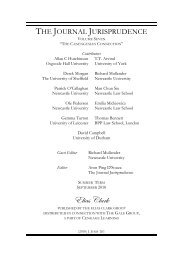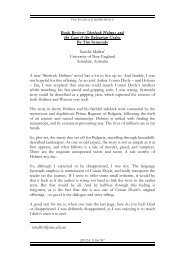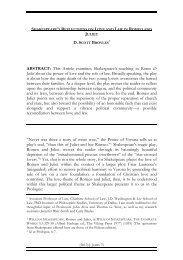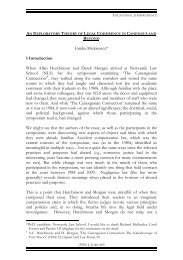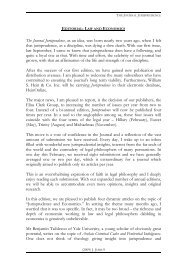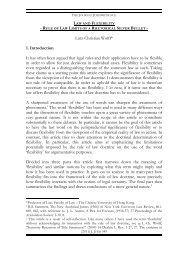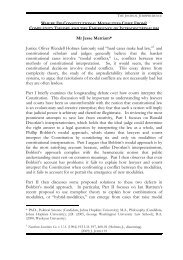On the Formation of the American Corporate State - The Journal ...
On the Formation of the American Corporate State - The Journal ...
On the Formation of the American Corporate State - The Journal ...
Create successful ePaper yourself
Turn your PDF publications into a flip-book with our unique Google optimized e-Paper software.
SKOURAS ON THE FORMATION OF THE AMERICAN CORPORATE STATE:THE FULLER SUPREME COURT, 1888-1910until fairly late in <strong>the</strong> nineteenth century. Consequently modern <strong>the</strong>orists suchas Ackerman, who defend <strong>the</strong> actions <strong>of</strong> <strong>the</strong>se Courts, on democraticprinciples are in fact defending a mythology <strong>of</strong> democracy.b) <strong>The</strong> Classical-Liberal Conservative School---James W. Ely, Jr.Ely, and o<strong>the</strong>r members <strong>of</strong> <strong>the</strong> Lockean school, 55 find that laissez-faire 56capitalism was an accepted philosophy <strong>of</strong> <strong>the</strong> Gilded Age. And natural lawserved as a foundational doctrine for <strong>the</strong> capitalist market. By anchoring <strong>the</strong>Due Process Clause in natural law, <strong>the</strong> justices were able to remove it fromdemocratic demands.Ely represents a school <strong>of</strong> classic-liberal conservatism. He points out that <strong>the</strong>Fuller Court provided continuity and stability to <strong>the</strong> nation. By appealing tonatural law, <strong>the</strong> justices could remove property from <strong>the</strong> threat <strong>of</strong> legislativeconfiscation. 57 Ely puts it this way: “Evidently influenced by natural law55 JAMES W. ELY, JR., THE GUARDIAN OF EVERY OTHER RIGHT: A CONSTITUTIONALHISTORY OF PROPERTY RIGHTS (1992), THE CHIEF JUSTICESHIP OF MELVILLE W. FULLER1888-1910 (1995), Property Rights and Democracy in <strong>the</strong> <strong>American</strong> Constitutional Order, in THEJUDICIAL BRANCH (Kermit L. Hall & Kevin T. McGuire, eds. 2005) and Economic Due ProcessRevisited, VAND. L. REV. 213 (1991); FORREST MCDONALD, WE THE PEOPLE: THE ECONOMICORIGINS OF THE CONSTITUTION (1958); Randy E, Barnett, Constitutional Legitimacy, 103 COLUM.L. REV. 111 (2003); BERNARD H. SIEGAN, PROPERTY RIGHTS: FROM THE MAGNA CARTA TOTHE FOURTEENTH AMENDMENT (2001); Miriam Galston and William Galson, Reason, Consent,and <strong>the</strong> U.S. Constitution: Bruce Ackerman's "We <strong>the</strong> People", 104 ETHICS 446 (1994) (Galston’s arerights foundationalists first); Charles W. McCurdy, Justice Field and <strong>the</strong> Jurisprudence <strong>of</strong> Government-Business Relations: Some Parameters <strong>of</strong> Laissez-Faire Constitutionalism 1863-1897, 61 JOURNAL OFAMERICAN HISTORY 970 (1975) and <strong>American</strong> Law and <strong>the</strong> Marketing Structure <strong>of</strong> <strong>the</strong> LargeCorporation 1875-1890, 38 JOURNAL OF ECONOMIC HISTORY 631 (1978); Paul Murphy, Time toReclaim: <strong>The</strong> Current Challenge <strong>of</strong> <strong>American</strong> Constitutional History, 69 AM. HIST. REV. 64-79(October 1963); Alan Jones, Thomas M. Cooley and <strong>the</strong> Interstate Commerce Commission: Continuity andChange in <strong>the</strong> Doctrine <strong>of</strong> Equal Rights, 8 POLITICAL SCIENCE QUARTERLY 602-627 (1966) andThomas M. Cooley and ‘Laissez-Faire Constitutionalism’: A Reconsideration, JOURNAL OF AMERICANHISTORY 752-771 (1967); RICHARD A. EPSTEIN, TAKINGS: PRIVATE PROPERTY AND THE LAWOF EMINENT DOMAIN (1985) and BARGAINING WITH THE STATE (1993); RAOUL BERGER,THE FOURTEENTH AMENDMENT AND THE BILL OF RIGHTS (1989) and GOVERNMENT BYJUDICIARY: THE TRANSFORMATION OF THE FOURTEENTH AMENDMENT (2 nd ed., 1997).56 Ely, GUARDIAN OF EVERY OTHER RIGHT at 88 (“Because judges are influenced bysocial forces and intellectual currents in general society, <strong>the</strong> principles <strong>of</strong> laissez-faireconstitutionalism gained currency among Supreme Court justices in <strong>the</strong> 1880s.”)57 EDWARD CORWIN, THE “HIGHER LAW” BACKGROUND TO AMERICAN CONSTITUTIONALLAW (Cornell University Press, 1928) (First printed as Harvard Law Review Article, Edward S.Corwin, <strong>The</strong> “HigherLaw” Background <strong>of</strong> <strong>American</strong> Constitutional Law, 62 HARV. L. REV. 149(1928)) ; see also, <strong>the</strong> liberal defense <strong>of</strong> property on natural law grounds, JOHN LOCKE, TWOTREATISES ON GOVERNMENT (Peter Laslett ed., 3 rd ed., Cambridge University Press, 1988) and(2011) J. JURIS 52



